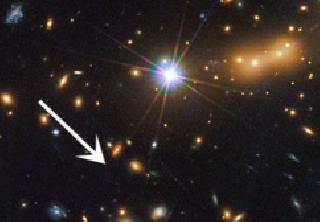
The newly discovered galaxy, named MACS0647-JD, is very young and only a tiny fraction of the size of our Milky Way. The object is observed 420 million years after the big bang. A NASA photo
WASHINGTON (PTI): In a new breakthrough, astronomers have discovered the most distant galaxy ever seen in the Universe.
By combining the power of NASA's Hubble and Spitzer space telescopes and one of nature's own natural "zoom lenses" in space, astronomers have discovered the farthest galaxy, which appears as a diminutive blob that is only a tiny fraction of the size of our Milky Way galaxy.
The galaxy offers a peek back into a time when the Universe was 3 per cent of its present age of 13.7 billion years.
Named MACS0647-JD, the galaxy was observed 420 million years after the big bang, the theorised beginning of the Universe. Its light has traveled 13.3 billion years to reach Earth.
This finding is the latest from a programme that uses natural zoom lenses to reveal distant galaxies in the early Universe.
Along the way, 8 billion years into its journey, light from MACS0647-JD took a detour along multiple paths around the massive galaxy cluster MACS J0647+7015. Without the cluster's magnification powers, astronomers would not have seen this remote galaxy.
Because of gravitational lensing, The Cluster Lensing And Supernova Survey with Hubble (CLASH) research team was able to observe three magnified images of MACS0647-JD with the Hubble telescope.
The cluster's gravity boosted the light from the faraway galaxy, making the images appear about eight, seven, and two times brighter than they otherwise would that enabled astronomers to detect the galaxy more efficiently and with greater confidence.
"This cluster does what no manmade telescope can do. Without the magnification, it would require a Herculean effort to observe this galaxy," said Marc Postman of the Space Telescope Science Institute in Baltimore.
MACS0647-JD is so small it may be in the first steps of forming a larger galaxy. An analysis shows the galaxy is less than 600 light-years wide.
Based on observations of somewhat closer galaxies, astronomers estimate that a typical galaxy of a similar age should be about 2,000 light-years wide.
For comparison, the Large Magellanic Cloud, a dwarf galaxy companion to the Milky Way, is 14,000 light-years wide. Our Milky Way is 150,000 light-years across.
 Previous Article
Previous Article Next Article
Next Article













The Indian Air Force, in its flight trials evaluation report submitted before the Defence Ministry l..
view articleAn insight into the Medium Multi-Role Combat Aircraft competition...
view articleSky enthusiasts can now spot the International Space Station (ISS) commanded by Indian-American astr..
view article